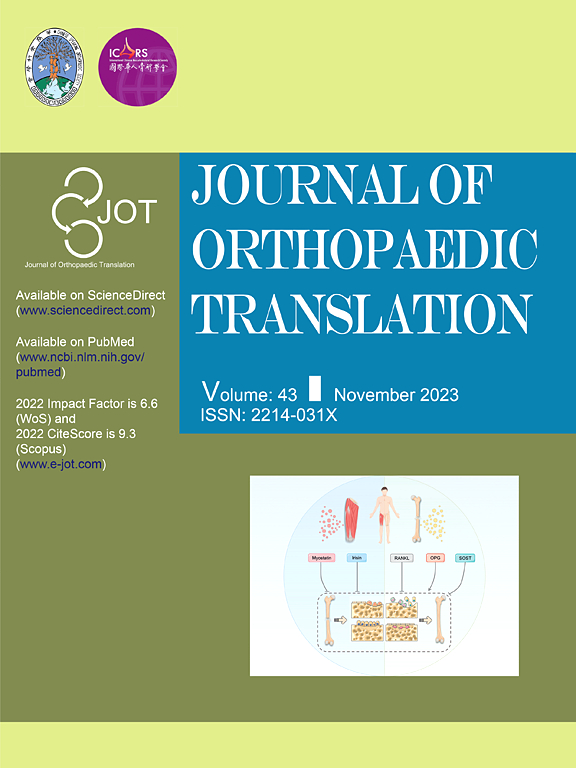Regenerative strategies for intervertebral disc degeneration
IF 5.9
1区 医学
Q1 ORTHOPEDICS
引用次数: 0
Abstract
Low back pain (LBP) is a global health problem, primarily caused by intervertebral disc (IVD) degeneration. Current treatments focus on symptom relief without addressing the underlying degenerative mechanisms. Regenerative strategies have emerged as promising therapies through the use of functional biomaterials and stem cells capable of modulating key signalling pathways to promote tissue regeneration. However, challenges such as efficient delivery systems, long-term survival of transplanted cells, and hostile disc microenvironment remain. This review focuses on recent advances in regenerative approaches using biomaterials, cells, and therapeutic agents of exosomes, and genes to restore IVD structure and function. We discuss the current understanding of IVD anatomy, physiology and degeneration pathophysiology followed by current treatments. We highlight the rationale for regenerative therapy in halting the degenerative hallmarks tailored to mild, moderate to severe IVD degeneration. Our review emphasizes on the functional biomaterials designed for advanced delivery system, therapeutic intervention and IVD tissue engineering. We discuss the cell-based therapy, highlighting various cell sources, therapeutic effects, clinical trials and its obstacles. We discuss the use of therapeutic agents such as the genes and exosome therapies in IVD regeneration. The clinical translational potential of regenerative therapy is vast and promising, driven by advances in cellular therapies, biomaterials, and cell-free approaches like exosomes, which offer new avenues for regenerating degenerative IVDs. While significant progress has been made in developing safe, effective, and scalable treatments, challenges remain in immune compatibility, manufacturing, and regulatory pathways. Emerging innovations in gene editing, 3D bioprinting, and personalized approaches are poised to accelerate the translation of these therapies into mainstream medicine, with interdisciplinary collaboration and global efforts playing a crucial role in overcoming current bottlenecks and realizing the full potential of regenerative medicine to transform patient care. This article offers a comprehensive framework to guide preclinical research and future clinical translation of effective regenerative therapies, aiming at reducing the global burden of LBP and improving long-term patient outcomes.

椎间盘退变的再生策略
腰痛(LBP)是一个全球性的健康问题,主要是由椎间盘退变引起的。目前的治疗侧重于症状缓解,而没有解决潜在的退行性机制。通过使用功能性生物材料和能够调节关键信号通路以促进组织再生的干细胞,再生策略已成为有希望的治疗方法。然而,诸如高效的递送系统、移植细胞的长期存活和不利的椎间盘微环境等挑战仍然存在。本文综述了利用生物材料、细胞、外泌体治疗剂和基因来恢复IVD结构和功能的再生方法的最新进展。我们讨论了目前对IVD解剖、生理和变性病理生理的理解,以及目前的治疗方法。我们强调再生疗法的基本原理,以阻止针对轻度,中度至重度IVD变性的退行性特征。本文重点综述了用于高级输送系统、治疗干预和IVD组织工程的功能生物材料。我们讨论了基于细胞的治疗,重点介绍了各种细胞来源,治疗效果,临床试验和它的障碍。我们讨论了治疗药物如基因和外泌体治疗在IVD再生中的应用。再生疗法的临床转化潜力巨大,前景广阔,这得益于细胞疗法、生物材料和外泌体等无细胞方法的进步,这些方法为退行性ivd的再生提供了新的途径。虽然在开发安全、有效和可扩展的治疗方法方面取得了重大进展,但在免疫相容性、制造和调控途径方面仍然存在挑战。基因编辑、3D生物打印和个性化方法方面的新兴创新有望加速这些疗法向主流医学的转化,跨学科合作和全球努力在克服当前瓶颈和实现再生医学的全部潜力方面发挥着至关重要的作用。本文提供了一个全面的框架来指导临床前研究和未来有效再生疗法的临床转化,旨在减轻LBP的全球负担,改善患者的长期预后。
本文章由计算机程序翻译,如有差异,请以英文原文为准。
求助全文
约1分钟内获得全文
求助全文
来源期刊

Journal of Orthopaedic Translation
Medicine-Orthopedics and Sports Medicine
CiteScore
11.80
自引率
13.60%
发文量
91
审稿时长
29 days
期刊介绍:
The Journal of Orthopaedic Translation (JOT) is the official peer-reviewed, open access journal of the Chinese Speaking Orthopaedic Society (CSOS) and the International Chinese Musculoskeletal Research Society (ICMRS). It is published quarterly, in January, April, July and October, by Elsevier.
 求助内容:
求助内容: 应助结果提醒方式:
应助结果提醒方式:


